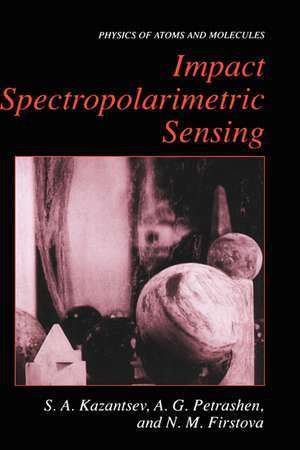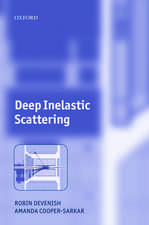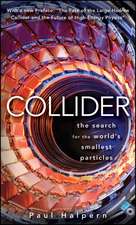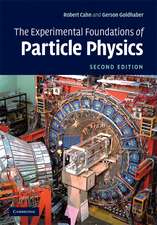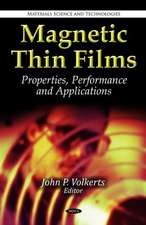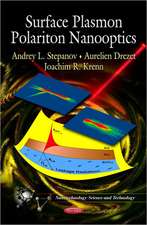Impact Spectropolarimetric Sensing: Physics of Atoms and Molecules
Autor Sergi Kazantsev, Natalia M. Firstova, Alexander G. Petrashenen Limba Engleză Hardback – 31 aug 1999
| Toate formatele și edițiile | Preț | Express |
|---|---|---|
| Paperback (1) | 1220.57 lei 6-8 săpt. | |
| Springer Us – 27 sep 2012 | 1220.57 lei 6-8 săpt. | |
| Hardback (1) | 1226.73 lei 6-8 săpt. | |
| Springer Us – 31 aug 1999 | 1226.73 lei 6-8 săpt. |
Din seria Physics of Atoms and Molecules
-
 Preț: 399.88 lei
Preț: 399.88 lei - 18%
 Preț: 1268.07 lei
Preț: 1268.07 lei -
 Preț: 386.99 lei
Preț: 386.99 lei - 18%
 Preț: 959.98 lei
Preț: 959.98 lei - 15%
 Preț: 650.55 lei
Preț: 650.55 lei - 15%
 Preț: 651.02 lei
Preț: 651.02 lei - 18%
 Preț: 948.47 lei
Preț: 948.47 lei -
 Preț: 404.29 lei
Preț: 404.29 lei - 18%
 Preț: 954.77 lei
Preț: 954.77 lei - 15%
 Preț: 685.20 lei
Preț: 685.20 lei - 18%
 Preț: 1260.34 lei
Preț: 1260.34 lei - 5%
 Preț: 658.82 lei
Preț: 658.82 lei - 15%
 Preț: 661.14 lei
Preț: 661.14 lei - 18%
 Preț: 953.35 lei
Preț: 953.35 lei -
 Preț: 402.17 lei
Preț: 402.17 lei - 15%
 Preț: 645.47 lei
Preț: 645.47 lei - 18%
 Preț: 1222.49 lei
Preț: 1222.49 lei - 18%
 Preț: 959.67 lei
Preț: 959.67 lei - 18%
 Preț: 952.72 lei
Preț: 952.72 lei - 15%
 Preț: 664.43 lei
Preț: 664.43 lei - 18%
 Preț: 952.89 lei
Preț: 952.89 lei - 15%
 Preț: 662.16 lei
Preț: 662.16 lei -
 Preț: 392.75 lei
Preț: 392.75 lei - 20%
 Preț: 555.28 lei
Preț: 555.28 lei - 15%
 Preț: 638.57 lei
Preț: 638.57 lei - 15%
 Preț: 648.24 lei
Preț: 648.24 lei - 18%
 Preț: 1233.06 lei
Preț: 1233.06 lei - 18%
 Preț: 1233.83 lei
Preț: 1233.83 lei -
 Preț: 390.08 lei
Preț: 390.08 lei - 18%
 Preț: 957.44 lei
Preț: 957.44 lei -
 Preț: 389.49 lei
Preț: 389.49 lei - 18%
 Preț: 950.66 lei
Preț: 950.66 lei - 15%
 Preț: 603.70 lei
Preț: 603.70 lei - 15%
 Preț: 587.85 lei
Preț: 587.85 lei - 15%
 Preț: 643.65 lei
Preț: 643.65 lei - 18%
 Preț: 1230.84 lei
Preț: 1230.84 lei
Preț: 1226.73 lei
Preț vechi: 1496.01 lei
-18% Nou
Puncte Express: 1840
Preț estimativ în valută:
234.73€ • 244.60$ • 194.36£
234.73€ • 244.60$ • 194.36£
Carte tipărită la comandă
Livrare economică 03-17 aprilie
Preluare comenzi: 021 569.72.76
Specificații
ISBN-13: 9780306458927
ISBN-10: 0306458926
Pagini: 361
Ilustrații: XI, 361 p.
Dimensiuni: 155 x 235 x 22 mm
Greutate: 0.7 kg
Ediția:1999
Editura: Springer Us
Colecția Springer
Seria Physics of Atoms and Molecules
Locul publicării:New York, NY, United States
ISBN-10: 0306458926
Pagini: 361
Ilustrații: XI, 361 p.
Dimensiuni: 155 x 235 x 22 mm
Greutate: 0.7 kg
Ediția:1999
Editura: Springer Us
Colecția Springer
Seria Physics of Atoms and Molecules
Locul publicării:New York, NY, United States
Public țintă
ResearchCuprins
1. Physical Introduction: Concepts, Phenomenology, Retrospectives, Applications.- 1.1. Polarization of Atomic Ensembles in Ionized Media.- 1.2. Polarization of Solar Flare Emission.- 1.3. Impact Polarization.- 1.4. Gas Discharge Studies.- 1.5. Collisional Kinetics of Polarization.- 1.6. Spectropolarimetric Sensing.- 1.7. Polarization Effects in the Earth Atmosphere.- 2. Polarization of a Photon Beam.- 2.1. Introduction.- 2.2. Wave Function of a Photon.- 2.3. Momentum, Spin, and Parity of a Photon.- 2.4. Rotation Matrix.- 2.5. Spinors.- 2.6. Relationship between the Polarization Direction and Characteristics of a Photon.- 2.7. Relationship between Stokes Parameters and the Characteristics of an Optical Field.- 2.8. Concluding Remarks.- 3. Theory of Collisional Spectropolarimetric Effects.- 3.1. Introduction.- 3.2. Density Matrix of an Atomic Ensemble.- 3.3. Polarization Density Matrix.- 3.4. Polarization Moments of the Density Matrix.- 3.5. Physical Meaning of Polarization Moments.- 3.6. Polarization Moments and Spectral Characteristics of an Atomic Ensemble.- 3.7. Density Matrix Relaxation Theory.- 3.8. Collisional Evolution of Polarization Moments.- 3.9. Interaction with an Electromagnetic Field.- 3.10. Impact Alignment Cross Section.- 3.11. Anisotropic Collisional Relaxation of Excited Hydrogen Atoms.- 3.12. Spectropolarimetric Effects for Angular Correlation Experiments.- 3.13. Concluding Remarks.- 4. Fast Particle Collision with a Heavy Atomic Target.- 4.1. Introduction.- 4.2. Born Expansion of the Scattering Amplitude.- 4.3. The Glauber Approximation.- 4.4. The System of Impact Parameter Equations.- 4.5. Concluding Remarks.- 5. Theory of Anisotropic Collisional Relaxation.- 5.1. Introduction.- 5.2. Symmetry of the Collisional Relaxation Cross Section Matrix.- 5.3.Rate Constants of Collisional Relaxation in Case of Partial Anisotropy.- 5.4. Distribution Functions of Relative Velocities.- 5.5. Collisional Relaxation of Polarization Moments under Intermultiplet Mixing.- 5.6. Anisotropie Collisional Alignment of a Narrow Multiplet.- 5.7. Anisotropie Relaxation and Polarization of Light.- 5.8. Depolarizing Collisions with Charged Particles.- 5.9. Concluding Remarks.- 6. Theory of Charge Exchange Polarization.- 6.1. Introduction.- 6.2. Theory of an Electron in the Field of Two Coulomb Centers.- 6.3. Distorted Wave Approximation Theory.- 6.4. Pseudolevel Technique for Computing the Polarization of Ions.- 6.5. Concluding Remarks.- 7. Spectropolarimeters for Solar Problems.- 7.1. Introduction.- 7.2. Spectropolarimetric Techniques of Meudon Observatory (France).- 7.3. Polarimetric Observations in the Crimean Astrophysical Observatory (Ukraine).- 7.4. The Spectropolarimeter of the Institute of Solar and Terrestrial Physics (Irkutsk, Russia).- 7.5. Solar Spectropolarimeter of Sacramento Peak Observatory (USA).- 7.6. Concluding Remarks.- 8. Solar Flare Observations at the Crimean Astrophysical Observatory (Ukraine).- 8.1. Introduction.- 8.2. Technique of Observation and Data Processing.- 8.3. Degree of Polarization along the Hydrogen H? Line.- 8.4. Spatial Distribution of the Degree of Polarization.- 8.5. Orientation of the Polarization Plane.- 8.6. Concluding Remarks.- 9. Observations of Polarization Effects at the Irkutsk Institute of Solar and Terrestrial Physics (Russia).- 9.1. Introduction.- 9.2. Spectropolarimetric Parameters of H? and H? Lines for the Flare on 15.09.1981.- 9.3. Spectropolarimetric Parameters of the Active Region 5669 (SGD) on 07.09.1989.- 9.4. Detection of the Linear Polarization of the Flare on 16.05.1991.- 9.5.Concluding Remarks.- 10. Solar Flare Observations at Meudon Observatory (France).- 10.1. Introduction.- 10.2. Linear Polarization of Emission of the Flare on 17.05.1980.- 10.3. Spectropolarimetric Effects of the Flare on 15.07.1980.- 10.4. Spectropolarimetric Features of Three Flares on 11.07.1982.- 10.5. Polarization Effects of the Emission of Two Flares on 17.07.1982.- 10.6. Concluding Remarks.- 11. Spectropolarimetric Measurements of Mustaches.- 11.1. Introduction.- 11.2. Polarization of Emission of Mustaches near the Solar Limb.- 11.3. Spectropolarimetric Measurements of Mustaches with an H? Filter.- 11.4. Improved Spectropolarimetric Observations of Mustaches on 14.11.1985.- 11.5. Observations of Mustaches at Baikal Astrophysical Observatory.- 11.6. Observations of Mustaches at Sacramento Peak Observatory.- 11.7. Concluding Remarks.- 12. Methodology of Impact Spectropolarimetric Sensing.- 12.1. Introduction.- 12.2. Spectropolarimetric Sensing Using Ground-Based Observations.- 12.3. Role of the Solar Magnetic Field.- 12.4. Linear Polarization of H? and H? Hydrogen Lines in the Born Approximation.- 12.5. Linear Polarization of the H? Hydrogen Line in the Glauber Approximation.- 12.6. Linear Polarization of H? and H? Hydrogen Lines by the Impact Parameter Method.- 12.7. Linear Polarization of the L? Hydrogen Line.- 12.8. Concluding Remarks.- 13. Impact Spectropolarimetric Diagnostics of Nonthermal Phenomena in the Solar Atmosphere.- 13.1. Introduction.- 13.2. Energy Transport into the Chromospheric Region of a Solar Flare.- 13.3. Determination of Proton Energy for the Flare on 16.05.1991.- 13.4. Impact Spectropolarimetric Sensing for the Flare on 15.09.1981.- 13.5. Impact Spectropolarimetric Sensing of Mustaches.- 13.6. Concluding Remarks.- 14. Conclusions.-References.
